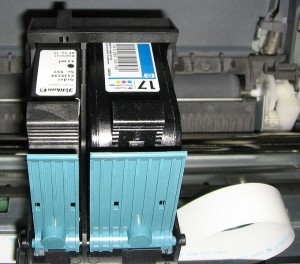 I haven’t done the research myself to verify this, but according to something I read not long ago, printer ink is the most expensive commodity on the planet by weight.
I haven’t done the research myself to verify this, but according to something I read not long ago, printer ink is the most expensive commodity on the planet by weight.
Seems reasonable to me. How else can they sell you a printer for so little and make any money? They want you using the ink, obviously. One printer I owned didn’t let me print in black and white (the majority of my use) if the color cartridge ran out. Once you buy the darn thing, they gotcha. Buy more ink cartridges at an outrageous price or stare at a boat anchor sitting by your desk.
 Manufacturers of other consumer products have caught on to the inkjet business model in which consumables provide the vast majority of the profit. Get enough people buying into that, and they support some other dude’s private jet.
Manufacturers of other consumer products have caught on to the inkjet business model in which consumables provide the vast majority of the profit. Get enough people buying into that, and they support some other dude’s private jet.
The latest example of this trickery in my life is a Keurig single-cup coffee brewer. A family member uses one, which apparently has worked fine for a long while, and I decided to try a Keurig B70 as a Christmas present to myself. Sometime on the afternoon of December 25, 2010, I brewed my first cup from the sample pack and thought, Is this cool, or what?
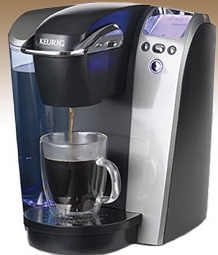 I like strong coffee. As the rancher-father of a friend reportedly described it, “I’ll be darned if I’m gonna drink a gallon of water to get a single cup of coffee.” Amen, sir.
I like strong coffee. As the rancher-father of a friend reportedly described it, “I’ll be darned if I’m gonna drink a gallon of water to get a single cup of coffee.” Amen, sir.
The array of coffees available in the single-serving K-cups dazzled me. As you might imagine, I focused on extra bold dark roast varieties and thought I’d arrived in coffee heaven: in about a minute, one hot, fresh mug of java that will darn near support a spoon vertical in the cup. Real coffee, worthy of the name.
Okay, so there’s got to be a downside, right? There are two: the brewer isn’t cheap, and neither is the coffee, but you can find both at discount stores and avoid paying full retail. Each cup still costs more than if you brewed a pot in a standard coffee maker, but on the other hand you don’t end up throwing out a half pot of stale coffee, either.
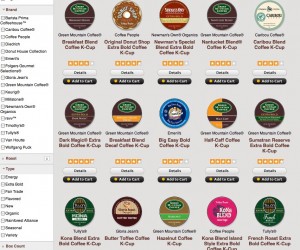 I tried the sample pack that came with the brewer, settled on a few favorite varieties, and ordered some boxes online. It was great . . . until the problems started, problems that apparently have been around with these brewers since 2006 or thereabouts, and which I would have known about if I had only taken the time to do a bit of research.
I tried the sample pack that came with the brewer, settled on a few favorite varieties, and ordered some boxes online. It was great . . . until the problems started, problems that apparently have been around with these brewers since 2006 or thereabouts, and which I would have known about if I had only taken the time to do a bit of research.
The Keurig is notorious, at least on a number of coffee lover forums, for displaying a NOT READY light that won’t go away unless you press the menu and brew buttons in just the right order while rubbing your stomach and head simultaneously and standing on one leg. It’s also developed a reputation for failure to brew and brewing “short cups” of less than the selected amount of water for the size of cup you want.
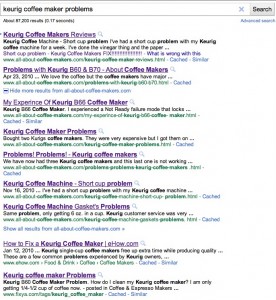 Since I didn’t know any of this before I bought it, the big surprise came when my brewer began acting up. I Googled “Keurig coffee maker problems” and found a full page of links. Some comments mentioned having gone through as many as five replacement brewers, readily supplied by polite customer service voices. The only catch is the requirement to return the removable K-cup holder assembly from the old unit as “proof of purchase,” although they don’t offer a prepaid postage option for doing that. A minor irritant in the total scheme of things, but in principle it’s still aggravating.
Since I didn’t know any of this before I bought it, the big surprise came when my brewer began acting up. I Googled “Keurig coffee maker problems” and found a full page of links. Some comments mentioned having gone through as many as five replacement brewers, readily supplied by polite customer service voices. The only catch is the requirement to return the removable K-cup holder assembly from the old unit as “proof of purchase,” although they don’t offer a prepaid postage option for doing that. A minor irritant in the total scheme of things, but in principle it’s still aggravating.
I read about fifty comments, few of which mentioned having found a permanent solution, and finally decided to contact Keurig customer service for myself. I can confirm being treated politely, and also being handled from a prepared script. When I finally made it to a technician to help solve the issues of failure to brew and brewing short cups, I patiently answered the questions and followed the instructions mentioned time and time again on the forums. After thirty minutes, the voice offered to send a new brewer to my house at no charge, except for the caution that if I don’t return the old K-cup holder assembly, I will be charged for the replacement brewer. Like I’m going through all this hassle to defraud them of a brewer that works as advertised.
From everything I can gather, Keurig has had this problem with the brewers for years, and it has nothing to do with customers using unfiltered water, or failing to periodically clean out the three nozzles in the needle that punctures the top of the K-cups, or not seating the water reservoir securely on the base, or failure to run a brew cycle of plain water after making a cup of hot cocoa.
It’s a design flaw, pure and simple, and rather than deal with that by acknowledging the problem, Keurig insists on putting customers through a series of procedures that has never solved anything, then sending out replacement brewers that will prove to be no less flawed than the originals.
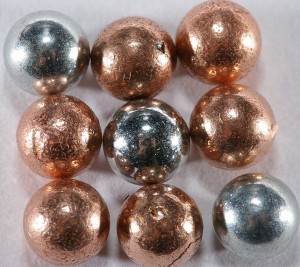 One comment on the forums indicated a possible solution. A customer studied how the brewer works, and during a failed brew cycle noticed water dribbling out of a 90-degree angled rubber spigot with two holes at upper rear of the water reservoir. He concluded that there was no reason for water to return to the reservoir, asked the simple question of why it was doing that, and focused on the way in which water is delivered from the reservoir to the heated holding tank in the brewer.
One comment on the forums indicated a possible solution. A customer studied how the brewer works, and during a failed brew cycle noticed water dribbling out of a 90-degree angled rubber spigot with two holes at upper rear of the water reservoir. He concluded that there was no reason for water to return to the reservoir, asked the simple question of why it was doing that, and focused on the way in which water is delivered from the reservoir to the heated holding tank in the brewer.
So he experimented with it, and ultimately decided that the pump might be too weak to overcome a slight vacuum in the reservoir, or maybe an air bubble gets in the lines. His solution was to use a BB to plug the left hole in the spigot and bingo, his problem with failure to brew and short cups disappeared. I tried that yesterday, and so far, so good.
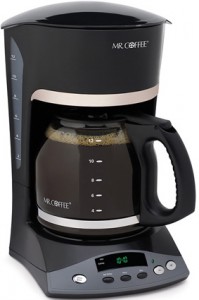 At this point, I am flabbergasted that Keurig has been unable to solve a persistent problem with their brewers and can remain in business by sending out replacements. And yes, I understand that customers who aren’t having problems don’t visit forums and there may be many more of them out there than those who are. But the corollary is also logical, that dissatisfied customers simply throw the offending brewers in the trash and go back to their old, reliable Mr. Coffee.
At this point, I am flabbergasted that Keurig has been unable to solve a persistent problem with their brewers and can remain in business by sending out replacements. And yes, I understand that customers who aren’t having problems don’t visit forums and there may be many more of them out there than those who are. But the corollary is also logical, that dissatisfied customers simply throw the offending brewers in the trash and go back to their old, reliable Mr. Coffee.
And the bottom line for Keurig has to be that the markup on the sale of original brewers and profit on the K-cups more than offsets the cost of providing free replacements.
It’s the inkjet business model in new clothing, and the customer is once again being fooled by the livery.



